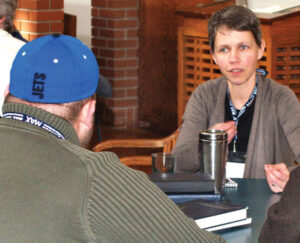I’ve had a number of conversations recently where the topic of truth has come up. Without exception, someone inevitably says, “There is no truth with a capital T. You have your truth and I have my truth. But there is no absolute Truth.”
This is what many people believe postmodernity claims. I want to begin a series of articles on the “Pursuit of truth” by briefly unpacking the impact of postmodernity on how we think and talk about truth. I realize the topic of postmodernity has been dialogued to death, so I will keep this brief, but I do think it’s important to revisit this subject on occasion. We can’t bear witness to truth in our time and place if we don’t understand our context, which, for most of us, is increasingly postmodern.
A friend of mine named Myron Penner first introduced me to Mennonite theology and postmodernity about 23 years ago. My life hasn’t been the same. He has written several books on postmodernity and Christianity since then, and defines postmodernity as “a kind of self-reflexive condition that emerges as modernity becomes conscious or aware of itself as modernity.”
Many describe postmodernity as more of an attitude about a worldview than a worldview itself, stemming from an awareness of the problems of the modern claims to rational superiority. With the risk of oversimplifying, we are postmodern when we become critically aware of our modern worldview and lose faith in the superiority of empiricism and logic.
To understand postmodernity, we must first understand modernity. The timeline of modernity is a matter of debate, but I believe the seeds were planted with the Renaissance in the 14th century, watered with the Reformation in the 16th century, and harvested with the Enlightenment in the 18th century. Modernity was essentially a shift in authority, epistemology (how we know what we know) and meta-narrative (the “grand story” that brings universal meaning).
In modernity, the authority of traditional institutions and divine revelation diminished, and the authority of empirical science and human reason expanded and increased. Modern epistemology was marked by suspicion and criticism of the supernatural and religious claims to truth, and a growing faith in human ability to know and explain reality. Logic and empirical science together were exalted as the way of knowing truth.
The metanarrative or “grand story” of the modern world was no longer revealed to us by God through divine revelation, but was discovered and created by us via reason, science and technology.
The postmodern shift, or “postmodern turn” as Penner calls it, is generally believed to have begun shortly after the Second World War, but there are differing timelines. In a sense, postmodernity is a disillusioned modernity. The Second World War epitomized the great disappointment in human reason, science and technology, and what they were capable of. The modern project had failed.
The result was a widespread critical mistrust of the authority, epistemology and metanarratives of modernity. Postmodernity suspiciously views all authority, hierarchy and power as social constructs that, although unavoidable, ought to be diffused as much as possible. There are no metanarratives or “grand stories” that explain existence and reality. Rather, meaning is a local, communal and personal enterprise. The postmodern epistemology is essentially pluralist, meaning there are many ways of knowing.
One postmodern perspective is extreme relativism. It believes truth is whatever a person or group decides. Very few people actually live this way for obvious reasons. This is not the “official” postmodern position on truth. In fact, I view it as the “fundamentalism” of postmodernity.
The basic postmodern attitude towards truth is a mistrust of certainty. The modern idea that reason is objective, universal and neutral is an illusion, thus certainty in knowing is impossible. Postmodernity doesn’t necessarily believe there is no absolute truth, or that truth is unknowable; the postmodern critique is, we can’t know if we know the truth. We cannot know truth with certainty because we can never get outside our own epistemological framework to examine or test our “interpretative structure.” You cannot be both inside and outside your worldview at the same time to objectively analyze it.
So our pursuit of truth as Christians has been influenced by the postmodern shift and ought to relate to the postmodern context we find ourselves living in. However, the notion “there is no Truth” simply isn’t true. If it was, it would be a self-refuting idea.
To be continued. . . . See Part 2.
Troy Watson (troydw@gmail.com) is pursuing truth in the postmodern context.





Leave a Reply
You must be logged in to post a comment.